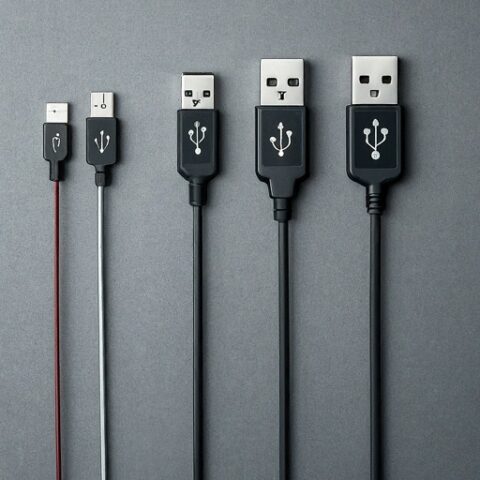USB (Universal Serial Bus) technology has evolved significantly since its introduction. From USB 1.0 to the latest USB 4.0, each iteration improves speed, power delivery, and functionality. Let’s explore the differences between USB 1.0, 1.1, 2.0, 3.0, and 4.0 in detail.
USB 1.0:
Introduced in January 1996, USB 1.0 was the first version of the USB standard. It provided a maximum data transfer rate of 1.5 Mbps (megabits per second), suitable for connecting peripherals like keyboards, mice, and printers. However, it was not ideal for transferring large files due to its slow speed.
USB 1.1:
Released in August 1998, USB 1.1 was an incremental update to USB 1.0, offering a data transfer rate of up to 12 Mbps. This increase in speed made it more practical for tasks like transferring documents and small multimedia files. USB 1.1 also introduced support for hubs and devices with multiple interfaces.
USB 2.0:
USB 2.0, introduced in April 2000, was a significant advancement over its predecessors. It offered a maximum data transfer rate of 480 Mbps, making it suitable for high-speed data transfer, multimedia streaming, and external storage devices like flash drives and external hard drives. USB 2.0 also introduced features like plug-and-play functionality and support for higher power output, enabling the charging of devices like smartphones and tablets.
USB 3.0:
USB 3.0, also known as SuperSpeed USB, was introduced in November 2008. It represented a major leap forward in USB technology, offering data transfer rates of up to 5 Gbps (gigabits per second), ten times faster than USB 2.0. USB 3.0 also introduced new power management features, improved protocol efficiency, and backward compatibility with USB 2.0 devices.
USB 3.1:
USB 3.1, announced in July 2013, further improved upon the USB 3.0 standard. It introduced a new Type-C connector with reversible plug orientation, higher data transfer rates of up to 10 Gbps (USB 3.1 Gen 2), and increased power delivery capabilities. USB 3.1 offered enhanced performance and versatility, making it ideal for a wide range of devices, including laptops, desktops, and mobile devices.
USB 3.2:
USB 3.2, introduced in September 2017, aimed to simplify the USB naming convention and improve data transfer speeds. It retained the USB 3.1 Gen 1 and Gen 2 specifications but introduced new marketing terms like USB 3.2 Gen 1 (formerly USB 3.0), USB 3.2 Gen 2 (formerly USB 3.1 Gen 2), and USB 3.2 Gen 2×2, which supports data transfer rates of up to 20 Gbps.
USB 4.0:
USB 4.0, announced in September 2019, is the latest iteration of the USB standard. It builds upon the USB 3.2 specification and incorporates Thunderbolt 3 technology, offering data transfer rates of up to 40 Gbps. USB 4.0 also introduces features like DisplayPort Alt Mode, enabling the transmission of video and audio signals over a single USB-C cable. Additionally, USB 4.0 provides improved power delivery and compatibility with existing USB devices.
Key Differences:
- Data Transfer Speed: USB 1.0 and 1.1 provided speeds of 1.5 Mbps and 12 Mbps, respectively. USB 2.0 increased this to 480 Mbps, while USB 3.0 and 3.1 offered speeds of up to 5 Gbps and 10 Gbps, respectively. USB 4.0 takes it further with speeds of up to 40 Gbps, making it suitable for high-bandwidth applications like video editing and gaming.
- Connector Types: USB 1.0 and 1.1 used the standard USB Type-A connector. USB 2.0 introduced the Mini-B and Micro-B connectors for smaller devices. USB 3.0 and 3.1 introduced the larger Type-B connector and the reversible Type-C connector. USB 4.0 continues to use the Type-C connector but with enhanced capabilities.
- Power Delivery: USB 2.0 provided limited power delivery for charging devices. USB 3.0 and 3.1 improved power delivery capabilities, allowing for faster charging of smartphones and tablets. USB 4.0 enhances power delivery further, supporting devices with higher power requirements, such as laptops and monitors.
- Backward Compatibility: USB 1.0, 1.1, and 2.0 devices are backward compatible with newer USB standards, but with reduced data transfer speeds. USB 3.0 and 3.1 devices are backward compatible with USB 2.0 ports. USB 4.0 maintains backward compatibility with USB 3.x devices, ensuring seamless connectivity across different generations of USB technology.
- Protocol Support: USB 4.0 incorporates Thunderbolt 3 technology, enabling support for additional protocols like PCIe and DisplayPort. This allows for versatile connectivity options, such as connecting external graphics cards and multiple 4K displays.
- Cost and Availability: With each new iteration, USB technology becomes more affordable and widely available. USB 4.0 devices are gradually entering the market, offering users access to the latest features and performance improvements.
Summary
In conclusion, USB technology has evolved significantly over the years, with each iteration bringing faster data transfer rates, enhanced power delivery, and improved functionality. From the basic connectivity of USB 1.0 to the high-speed capabilities of USB 4.0, USB has become an essential standard for connecting and powering a wide range of devices in today’s digital world.
